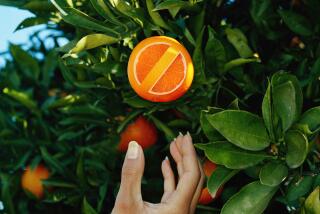Now’s the Time to Plant Bare-Root Fruit Trees
- Share via
Among the gifts of nature that help make summertime something special are juicy, sun-ripened peaches and nectarines. If you want your own trees, now’s the time to go into action, planting them while bare-root trees are available at nurseries. You can be picking fruit off your own tree in three years.
California orchards are the leading producers of peaches and nectarines. Nevertheless, in most of the southern half of the state, simply any type of tree will not do. Peach and nectarine trees require a certain amount of chilly weather--with temperatures ranging between 32 and 45 degrees Fahrenheit--or fruit production will be spotty.
A standard peach such as the popular Elberta requires 650 to 900 hours of chilling weather per season. That is a problem in many areas of Southern California--including most of Los Angeles, Orange, San Diego and Ventura counties, which usually receive only 250 to 400 hours of chilling weather during an average year. So if your Elberta or Hale peach tree has been a failure, a lack of chilling weather is the probable reason.
Given these factors, how does one successfully grow peaches and nectarines in the milder areas of Southern California? First, choose a variety that requires less chilling time than the standard varieties.
For much of the past five years, Dr. Franklin Laemmlen, a plant scientist with the UC Cooperative Extension, has been working with low-chill peach tree varieties at a research station in the Imperial Valley. According to Laemmlen, of the 20 low-chill peach varieties he has tested, the following five varieties were the most impressive:
* Florida Prince--The earliest maturing peach in his trials. Fruit ripens 60 to 70 days from bloom. Small to medium fruit with yellow flesh and outstanding flavor for an early peach. Pretty fruit are an intense yellow, splashed with red.
* Florida Glow--A white-fleshed peach that has beautiful creamy white skin with a pink blush. The white flesh has pink streaks through it. The flesh is low acid with a mild, sweet flavor. The fruit is very delicate and bruises easily, but it is simply delicious when allowed to ripen on the tree.
* Florida Crest--This is a favorite of Laemmlen because of its great flavor. The flesh is yellow, sweet and juicy; skin is a deep yellow with a red blush.
* Early Grande--Another yellow-fleshed variety that has very good quality if fruit is allowed to ripen on the tree. Pale yellow fruit blushed with red.
* Babcock--Although it did not do well because it ripened late in the intense heat of the Imperial Valley, Laemmlen says Babcock should produce well in the milder areas of Southern California. Babcock has medium-sized fruit with pure white flesh that turns red at the pit. Like Florida Glow, the flavor is sweet and mild. Babcock is an old favorite in Southland yards and its popularity is making a comeback.
Besides Laemmlen’s choices, I have been very impressed with the following low-chill peach trees:
* Mid-Pride--Produces medium-large yellow fruit that is blushed with red. Yellow flesh with a superb, rich flavor. Very low chilling requirement.
* August Pride--Produces large, round, yellow fruit of fine flavor and texture. Tree is large and vigorous. Fruit ripens three weeks later than Mid-Pride.
* Florida King--an early and prolific producer of large, juicy delicious fruit. The flesh is yellow and very sweet. The skin is yellow with a red blush.
As for nectarine varieties that are suitable for most Southland growing regions, fruit tree expert Chaun Aranyawat says that, like their peach cousins, there are a number of low-chill nectarine trees. Aranyawat, owner of Tomlinson’s Nursery in Whittier, a nursery that specializes in low-chill and tropical plants, recommends the following low-chill nectarine trees:
* Gold Mine--Probably the most frequently encountered variety in local nurseries. Large fruit with white skin splashed with red. White flesh has outstanding flavor.
* Desert Dawn--Produces small, good quality fruit with red skin. Juicy flesh is yellow.
* Panamint--A very productive tree suited to the mildest regions. Medium fruit has bright red skin, yellow flesh and good flavor.
* Silver Lode--Fruit ripens very early. Skin is white, blushed with scarlet. Has white, sweet flesh.
* Pioneer--A particularly handsome tree with large pink blossoms. Fruit has yellow skin blushed with red. Flesh is yellow and has superb flavor.
Bare-root trees for these peach and nectarine varieties should now be available at local nurseries. For some of the newer varieties, you may have to phone several nurseries to locate a tree.
Laemmlen recommends the following cultural practices for established trees.
Peach and nectarine trees don’t like “wet feet,” according to Laemmlen, so overwatering should be avoided. While young trees should be watered regularly until they have set down their root systems, established trees should be watered only when the top layer of soil has dried to four or five inches. This can be checked with a shovel--Laemmlen calls it “irrigating with a shovel.”
He says fertilizer should be applied in January or February so that the nutrients are available when the tree starts to leaf out. He uses a 10-5-5 formula fertilizer for his trees, but says that slow-release fertilizer tablets or spikes are also satisfactory.
Recently, especially last year, many Southland gardeners have complained about fungus diseases on their peach and nectarine trees. Laemmlen says that while the trees are dormant in December and January, they should be given a dormant spray that contains oil and copper. He says to cover the tree thoroughly over branches and trunk. According to Laemmlen, the oil takes care of overwintering insects like twig borers, mites and scale, and the copper helps prevent diseases such as brown rot, shot hole and leaf curl.
Peach and nectarine trees require yearly fruit thinning. To get good sized fruit, thinning is a must. Laemmlen says that most trees will go through a natural fruit-drop when the fruit reaches dime-size. After this drop, Laemmlen recommends that when the fruit reaches the size of a nickel, you should thin the fruit to seven to eight inches apart on early varieties and six inches on other varieties.
Both peach and nectarine trees need annual pruning during their dormant stage. Laemmlen recommends the purchase of a pruning book with diagrams that will guide you through the pruning process.
More to Read
Eat your way across L.A.
Get our weekly Tasting Notes newsletter for reviews, news and more.
You may occasionally receive promotional content from the Los Angeles Times.










